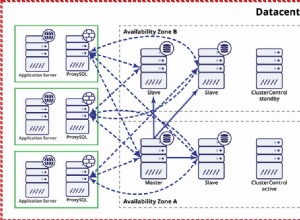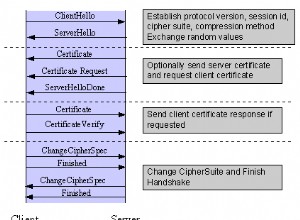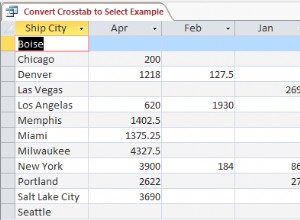Sie können dies in einem einzigen Aufruf von PHP zu MySQL tun, wenn Sie eine gespeicherte Prozedur verwenden:
Beispielanrufe
mysql> call category_hier(1);
+--------+---------------+---------------+----------------------+-------+
| cat_id | category_name | parent_cat_id | parent_category_name | depth |
+--------+---------------+---------------+----------------------+-------+
| 1 | Location | NULL | NULL | 0 |
| 3 | USA | 1 | Location | 1 |
| 4 | Illinois | 3 | USA | 2 |
| 5 | Chicago | 3 | USA | 2 |
+--------+---------------+---------------+----------------------+-------+
4 rows in set (0.00 sec)
$sql = sprintf("call category_hier(%d)", $id);
Hoffe das hilft :)
Vollständiges Skript
Tabellenstruktur testen:
drop table if exists categories;
create table categories
(
cat_id smallint unsigned not null auto_increment primary key,
name varchar(255) not null,
parent_cat_id smallint unsigned null,
key (parent_cat_id)
)
engine = innodb;
Testdaten:
insert into categories (name, parent_cat_id) values
('Location',null),
('USA',1),
('Illinois',2),
('Chicago',2),
('Color',null),
('Black',3),
('Red',3);
Verfahren:
drop procedure if exists category_hier;
delimiter #
create procedure category_hier
(
in p_cat_id smallint unsigned
)
begin
declare v_done tinyint unsigned default 0;
declare v_depth smallint unsigned default 0;
create temporary table hier(
parent_cat_id smallint unsigned,
cat_id smallint unsigned,
depth smallint unsigned default 0
)engine = memory;
insert into hier select parent_cat_id, cat_id, v_depth from categories where cat_id = p_cat_id;
/* http://dev.mysql.com/doc/refman/5.0/en/temporary-table-problems.html */
create temporary table tmp engine=memory select * from hier;
while not v_done do
if exists( select 1 from categories p inner join hier on p.parent_cat_id = hier.cat_id and hier.depth = v_depth) then
insert into hier
select p.parent_cat_id, p.cat_id, v_depth + 1 from categories p
inner join tmp on p.parent_cat_id = tmp.cat_id and tmp.depth = v_depth;
set v_depth = v_depth + 1;
truncate table tmp;
insert into tmp select * from hier where depth = v_depth;
else
set v_done = 1;
end if;
end while;
select
p.cat_id,
p.name as category_name,
b.cat_id as parent_cat_id,
b.name as parent_category_name,
hier.depth
from
hier
inner join categories p on hier.cat_id = p.cat_id
left outer join categories b on hier.parent_cat_id = b.cat_id
order by
hier.depth, hier.cat_id;
drop temporary table if exists hier;
drop temporary table if exists tmp;
end #
Testläufe:
delimiter ;
call category_hier(1);
call category_hier(2);
Einige Leistungstests mit Yahoo Geoplanet-Ortsdaten
drop table if exists geoplanet_places;
create table geoplanet_places
(
woe_id int unsigned not null,
iso_code varchar(3) not null,
name varchar(255) not null,
lang varchar(8) not null,
place_type varchar(32) not null,
parent_woe_id int unsigned not null,
primary key (woe_id),
key (parent_woe_id)
)
engine=innodb;
mysql> select count(*) from geoplanet_places;
+----------+
| count(*) |
+----------+
| 5653967 |
+----------+
Das sind also 5,6 Millionen Zeilen (Stellen) in der Tabelle. Mal sehen, wie die von PHP aufgerufene Adjazenzlistenimplementierung/gespeicherte Prozedur damit umgeht.
1 records fetched with max depth 0 in 0.001921 secs
250 records fetched with max depth 1 in 0.004883 secs
515 records fetched with max depth 1 in 0.006552 secs
822 records fetched with max depth 1 in 0.009568 secs
918 records fetched with max depth 1 in 0.009689 secs
1346 records fetched with max depth 1 in 0.040453 secs
5901 records fetched with max depth 2 in 0.219246 secs
6817 records fetched with max depth 1 in 0.152841 secs
8621 records fetched with max depth 3 in 0.096665 secs
18098 records fetched with max depth 3 in 0.580223 secs
238007 records fetched with max depth 4 in 2.003213 secs
Insgesamt bin ich ziemlich zufrieden mit diesen kalten Laufzeiten, da ich nicht einmal in Betracht ziehen würde, Zehntausende von Datenzeilen an mein Frontend zurückzugeben, sondern den Baum lieber dynamisch aufbauen und nur mehrere Ebenen pro Aufruf abrufen würde. Oh, und nur für den Fall, dass Sie dachten, innodb sei langsamer als myisam – die myisam-Implementierung, die ich getestet habe, war in jeder Hinsicht doppelt so langsam.
Mehr Material hier:http://pastie.org/1672733
Hoffe das hilft :)




